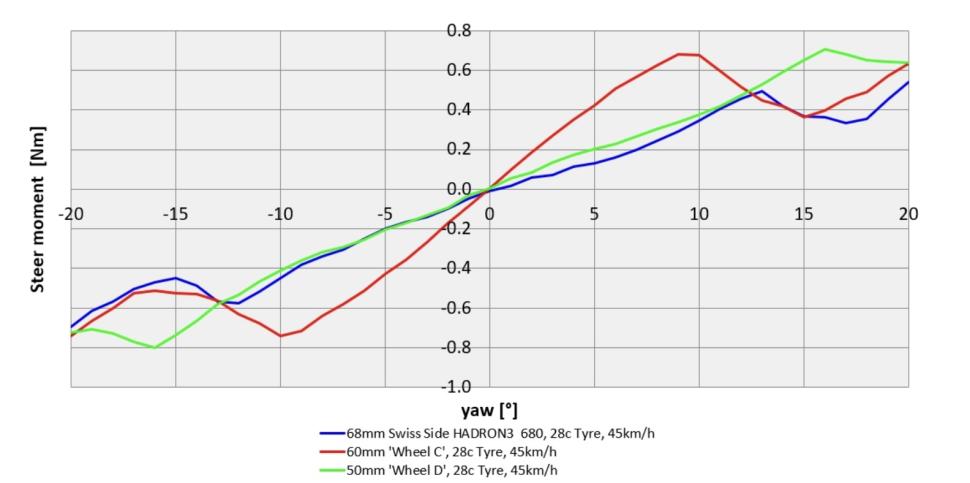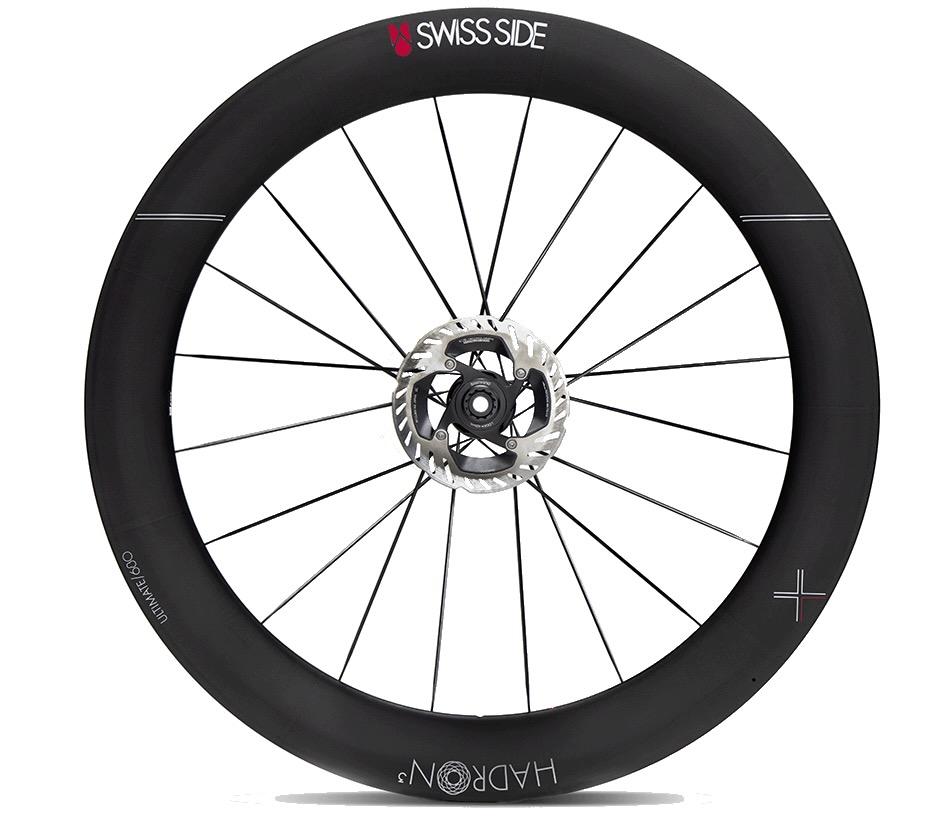Swiss Side has released an open letter to the UCI (Union Cycliste Internationale, cycle sport’s world governing body) requesting what it calls “an urgent reconsideration of the recent change to the equipment regulations implementation”. The wheel brand also calls for “meaningful change and responsible governance from the UCI, by including the cycling industry, and in particular experts in the relevant fields, as part of the decision-making process”.
Ouch! Shots fired.
If you’re not up to speed on this, the UCI last month announced plans to implement several new equipment rules, one of them being a maximum wheel rim depth of 65mm for mass-start road events, beginning at the start of next year.
From Swiss Side’s perspective, the decision isn’t great. In fact, it’s disastrous, the brand having just announced the launch of its 68mm-deep Hadron³ Ultimate 680 wheel.
Swiss Side provides wind tunnel data from tests made with wheels of different rim depths, including its new 68mm rim, in an attempt to show that this change would be ineffective. In fact, it goes further, saying that the new rule could “be counterproductive in bringing any improvement in wheel stability and thereby rider safety”.
Swiss Side is also keen to draw attention to the impact it believes the change would make to the industry, supply chain and, ultimately, to the consumer.
Swiss Side says that it is committed to improving the safety of cycling, but that, “This however has to be done in an objective and science-based manner, which leads to genuine improvements in safety.”
The whole idea of the open letter is to ask the UCI to reconsider the changes to the equipment regulations that have been announced, and also to ask that the cycling industry is involved in the decision-making process going forward.
Here’s the letter in full:
OPEN LETTER TO THE UCI
SUBJECT: Maximum rim height for UCI road racing
Dear Mr Lappartient and UCI Management Committee,
I write to you with reference to the recent change to the equipment regulations issued on 12th June 2025 and the clarification of 20th June 2025, in particular with regards to the maximum rim height.
First and foremost, Swiss Side is fully committed to improving the safety of cycling, both with regards to racing as well as for safety of end consumers. We very much support any initiative which leads to genuine improvements in safety for cycle racing and cycling in general.
With regards to the development of road cycling equipment, Swiss Side is a key industry leader in the research and development of road and time-trial wheels. Apart from the structural and functional integrity of the Wheel-Tyre-System (WTS), the aerodynamic characteristics, in particular the stability and predictable handling of the WTS in changing wind conditions, is of great importance for safety.
For this purpose, Swiss Side conducts extensive wind tunnel testing and on-road measurements as part of the R&D activities for engineering wheels, and has been a pioneer in developing specific wind tunnel and on-road measurement systems for this purpose. One key measurement is the steering moment, which objectively quantifies the reaction force of the front WTS, which the rider feels in the handlebar in crosswind (yaw) conditions. The measured steering moment characteristic of the front WTS has robustly shown over the last 10 years, to directly correlate to stability, predictable handling and safety.
With over 10 years of objective data from both the wind tunnel, on-road measurements, as well as rider feedback, Swiss Side would like to highlight, that the rim height has a limited impact on stability, predictable handling and safety. Through the objective measurement of the steering moment, we can firmly state that rim depth has far less influence than tyre width, tyre tread pattern (and its effect on the aerodynamic characteristics), and the steering geometry of the bike frame (steering axis angle and trail). Furthermore, the rim shape and depth are the parameters which enable tuning the handling characteristics of the wheel. Deeper rims, apart from having more mechanical stability due to the increased rotating inertia, also allow for better tuning of the aerodynamic and handling characteristic of the wheel. A poorly engineered rim shape or the wrong combination of rim shape and tyre, can lead to a very unstable, unpredictable and potentially unsafe aerodynamic characteristic, regardless of the rim depth.
To demonstrate this fact, below the analysis of the steering moment response of 3 wheels currently in use in the UCI World Tour, is shown. All three wheels are measured in the wind tunnel with the identical 28mm tyre, which is currently used extensively in the UCI World Tour. The three wheels have different rim depths: 50mm, 60mm, and our most recently released 68mm HADRON3 Ultimate rim.
 2025 Swiss Side table (credit: Swiss Side)
2025 Swiss Side table (credit: Swiss Side)
For good stability and predictable handing, the steering moment needs to be minimised, in particular in the main working range of +/- 15° yaw. Also, the gradient of the steering moment curve should be minimised. Finally, the change in steering moment magnitude after the point of airflow separation (stall characteristic), should be minimised. (The stall point can be seen for example, in the red curve at the +9° and -9° yaw points).
A ‘weighted steering moment’ value is also calculated by applying a weighting system which corresponds to the frequency of occurrence of each yaw angle in typical real-world wind conditions. (Lower yaw angles occur more frequently than higher yaw angles and are therefore given more weighting). The ‘weighted steering moment’ values for each wheel are:
– 0.45Nm 68mm Swiss Side HADRON3 680, 28c tyre, 45km/h
– 0.60Nm 60mm ‘Wheel C’, 28c tyre, 45km/h
– 0.51Nm 50mm ‘Wheel D’, 28c tyre, 45km/h
What can be objectively demonstrated here is that the 68mm rim has the least steering moment of all three wheels. In fact, despite being the deepest section rim, it is the most stable and quantifiably safe wheel from its aerodynamic characteristics.
The purpose here is to show the importance of an objective, science-based approach, which needs to be a part of the decision-making process for implementing equipment regulations.
The recently proposed limitation on the rim depth to 65mm for 2026, can be objectively shown with regards to the steering moment, and the front wheel handling characteristics, to be ineffective and even counterproductive in bringing any improvement in wheel stability and thereby rider safety.
This highlights the need for the cycling industry as a whole, including the brands, manufacturers, teams and experts, like Swiss Side, to be involved in providing experience and advice to the UCI, in the decision-making process for implementing equipment regulations.
Furthermore, the time, effort and cost to develop new equipment needs to be considered as part of the decision-making process. For example, the development of a high-level road cycling wheel is a 2.5 year development process, which can be broken down into the 5 key 6-month phases:
1. Project preparation, continuous research, market analysis, target definitions.
2. Aerodynamic development, including CFD and wind tunnel testing of 3D printed prototypes.
3. Composite engineering and industrialisation including tooling design.
4. Prototype production iterations.
5. Final production specification product testing, homologation and series production start.
The total cost for such a development is a six-figure sum (EUR), and is amortised by the sale of the product, typically over a 4-year product life cycle.
It is therefore understandable that 6-months’ notice on the implementation of new equipment regulations, such as the rim depth limitation, is inadequate. For Swiss Side, to uncover through the press, that the rim depth should be limited to 65mm for UCI road racing from 01.01.2026, only two weeks before launching our new 68mm HADRON3 Ultimate 680 wheel, was a major and unexpected and extremely costly blow, given the years of development invested in this new wheel.
It must also be noted that the cycling industry is one of the few sporting industries to boast such a large number and wide variety of brands, which form the backbone of the industry, ultimately to the benefit of the end consumer. Transparent communication, within a considered timeframe, is vital for viability and sustainability of the cycling industry.
Cycle racing and the entire industry is ultimately funded by the end consumers who purchase the products. The entire supply chain is built around the end consumer needs and demands. The sponsorship and financial support of the amateur and professional teams alike, are all part of this interdependent chain. The UCI’s unilateral decision to limit rim depth to 65mm, without a justifiable, quantifiable, and meaningful impact on safety, with only 6 months’ notice, has a direct and negative impact on the entire supply chain and ultimately, on the end consumer. They, including the amateur and professional cycling teams, are suddenly and unexpectedly left with products which they can potentially not use in UCI road racing in less than 6 months’ time. Also, for retailers, distributors, manufacturers and brands, the products which have been developed and produced, are diminished or even nullified in value. The financial implications for the entire supply chain, all the way down to the end consumer, are enormous.
This one looks set to run and run. What do you think?
